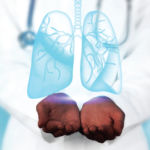Prior CT imaging showed migratory consolidative infiltrates. Recent CT imaging showed dense consolidation in the right middle lobe with air bronchograms.
“I performed bronchoscopy [because] I was worried about infection given lobar consolidation and high-dose steroids,” Dr. Wilfong said. “However, bronchoalveolar lavage revealed lipid-laden macrophages consistent with recurrent aspiration.”
The patient was found to have normal esophageal motility and, ultimately, underwent Nissen fundoplication with resolution of her CT findings. Surgical management of gastroesophageal reflux disease is associated with improved survival in IPF.3
“There are only so many ways the lung can repair itself, so you don’t need to be dumping stomach acid on it every night,” Dr. Wilfong said. “The challenge in our patient population is that Nissen fundoplication is contraindicated if there is significantly impaired esophageal motility.”
Thus, it may not be an option for all patients with SSc or myositis.
“This case underlines another critical point: An RA-ILD diagnosis should always be anti-CCP positive,” she said. “We know that RA likely starts in the lungs or the mouth, not the joints. So if an anti-CCP negative patient is diagnosed with RA-ILD, rethink that diagnosis.”4
For dermatomyositis—the true etiology of her inflammatory arthritis and rashes—the patient was treated with MMF, abatacept and hydroxychloroquine. Her PFTs have nearly normalized, and prednisone has been tapered to 5 mg daily.
Summary
To conclude, Dr. Wilfong stressed take-home points. Groundglass changes are likely to be inflammatory and potentially reversible, whereas fibrotic changes are currently irreversible. RA-ILD should always be anti-CCP positive. And don’t forget to rule out mimics, such as aspiration and infection, as a cause of worsening pulmonary function in your ILD patients.
She also encouraged the audience to start looking at the images we order. “ILD imaging is all about learning by doing,” she said. “Talk to your radiologists and review interesting scans together. For practice, find out if your institution has an ILD conference. That’s where all the weird CT scans go.”
Samantha C. Shapiro, MD, is an academic rheumatologist and an affiliate faculty member of the Dell Medical School at the University of Texas at Austin. She received her training in internal medicine and rheumatology at Johns Hopkins University, Baltimore. She is also a member of the ACR Insurance Subcommittee.
References
- Raghu G, Remy-Jardin M, Myers JL, et al. Diagnosis of idiopathic pulmonary fibrosis. An official ATS/ERS/JRS/ALAT clinical practice guideline. Am J Respir Crit Care Med. 2018 Sep 1;198(5):e44–e68.
- Wilfong EM, Young-Glazer JJ, Sohn BK, et al. Anti-tRNA synthetase syndrome interstitial lung disease: A single center experience. Respir Med. 2022 Jan;191:106432.
- Lee JS, Ryu JH, Elicker BM, et al. Gastroesophageal reflux therapy is associated with longer survival in patients with idiopathic pulmonary fibrosis. Am J Respir Crit Care Med. 2011 Dec 15;184(12):1390–1394.
- Pruijn GJM. Citrullination and carbamylation in the pathophysiology of rheumatoid arthritis. Front Immunol. 2015 Apr 27;6:192.

